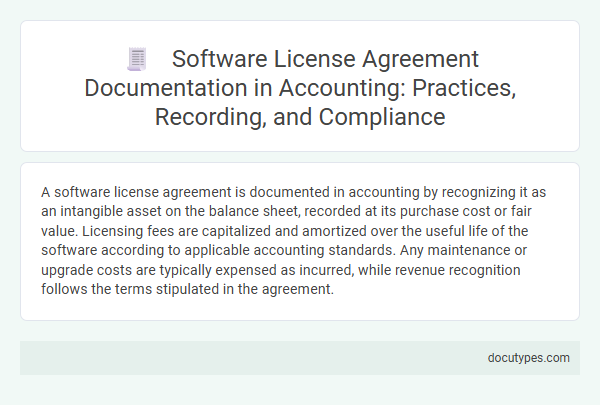A software license agreement is documented in accounting by recognizing it as an intangible asset on the balance sheet, recorded at its purchase cost or fair value. Licensing fees are capitalized and amortized over the useful life of the software according to applicable accounting standards. Any maintenance or upgrade costs are typically expensed as incurred, while revenue recognition follows the terms stipulated in the agreement.
Introduction to Software License Agreement Documentation in Accounting
How is a software license agreement documented in accounting? Software license agreements are recorded as intangible assets on the balance sheet. These agreements require careful classification to ensure proper amortization and expense recognition over the license term.
Key Components of a Software License Agreement
Software license agreements are crucial in accounting to define the rights and costs associated with software use. Your accounting records must reflect these agreements accurately for compliance and financial clarity.
- License Scope - Specifies the extent of the software usage rights granted, including user limits and geographic restrictions.
- Payment Terms - Details the cost structure such as one-time fees, subscription charges, or usage-based payments.
- Duration and Renewal - Defines the period the license covers and conditions for renewal or termination of the agreement.
Best Practices for Documenting Software Licenses in Accounting
Documenting a software license agreement in accounting requires accurate identification of the license type and cost allocation. Clear categorization between perpetual licenses, subscriptions, and usage-based licenses ensures proper financial treatment.
Best practices include maintaining detailed records of license terms, renewal dates, and payment schedules for audit readiness. Consistent application of revenue recognition principles and capitalization policies helps align financial reporting with accounting standards.
Recording Software License Agreements in Financial Statements
Software license agreements are recorded in financial statements as intangible assets when the company obtains the right to use the software over a specified period. The cost of acquiring the software license is capitalized and amortized over its useful life, reflecting the consumption of economic benefits. Regular impairment tests ensure that the carrying amount does not exceed the recoverable amount, maintaining accurate financial reporting.
Legal and Regulatory Compliance for Software License Agreements
Software license agreements are documented in accounting by recognizing the license as an intangible asset or an expense, depending on the terms and duration of the license. Accurate recording ensures compliance with financial reporting standards such as IFRS or GAAP.
Legal and regulatory compliance requires that the software license agreement clearly defines usage rights, payment terms, and renewal conditions. Maintaining thorough documentation supports audits and protects against legal risks associated with intellectual property and contract law.
Internal Controls for Managing Software License Documentation
Documenting a software license agreement in accounting requires precise internal controls to ensure accuracy and compliance. Implementing effective management processes helps maintain reliable records of software assets and associated agreements.
- Centralized Documentation Storage - Maintain all software license agreements in a secure, centralized repository to prevent loss and facilitate easy access during audits.
- Regular License Audits - Conduct scheduled audits comparing physical licenses against accounting records to verify compliance and identify discrepancies promptly.
- Access Controls and Segregation of Duties - Restrict document handling to authorized personnel and separate responsibilities to reduce risk of errors or fraudulent modifications.
Audit Trails and Verification of Software License Records
Software license agreements are documented in accounting through detailed audit trails and verification processes to ensure accuracy and compliance. Maintaining clear records supports financial reporting and legal adherence related to software usage rights.
- Audit Trail Creation - All transactions regarding software licenses, including purchases and renewals, are systematically recorded to provide a clear historical record.
- Verification of License Records - Regular reconciliation of software licenses against purchase orders and invoices guarantees validity and prevents unauthorized usage.
- Compliance Monitoring - Accounting documents are reviewed to confirm compliance with licensing terms and financial reporting standards.
Comprehensive documentation of software license agreements in accounting strengthens audit integrity and supports regulatory obligations.
Risk Management in Software License Agreement Documentation
Software license agreements are documented in accounting to ensure accurate recognition of software assets and related liabilities. Proper documentation supports compliance with accounting standards such as ASC 350 and IFRS IAS 38, which govern intangible assets.
Risk management in software license agreement documentation focuses on identifying financial obligations, usage rights, and potential penalties. Clear documentation helps mitigate risks associated with license overuse, non-compliance, or unexpected costs. You must maintain detailed records to safeguard against disputes and ensure transparent reporting of software expenses and amortization schedules.
Common Challenges in Accounting for Software Licenses
| Aspect | Details |
|---|---|
| Definition | A software license agreement outlines the terms under which software is licensed, including usage rights, duration, and payment obligations. |
| Accounting Documentation | Documented as an intangible asset or an expense, depending on whether the license provides enduring rights or is based on subscription models. |
| Common Challenges |
|
| Impact on Financial Statements | Incorrect classification may lead to misstated assets, liabilities, and expenses affecting profitability and balance sheet accuracy. |
| Best Practices |
|
How Is a Software License Agreement Documented in Accounting? Infographic

